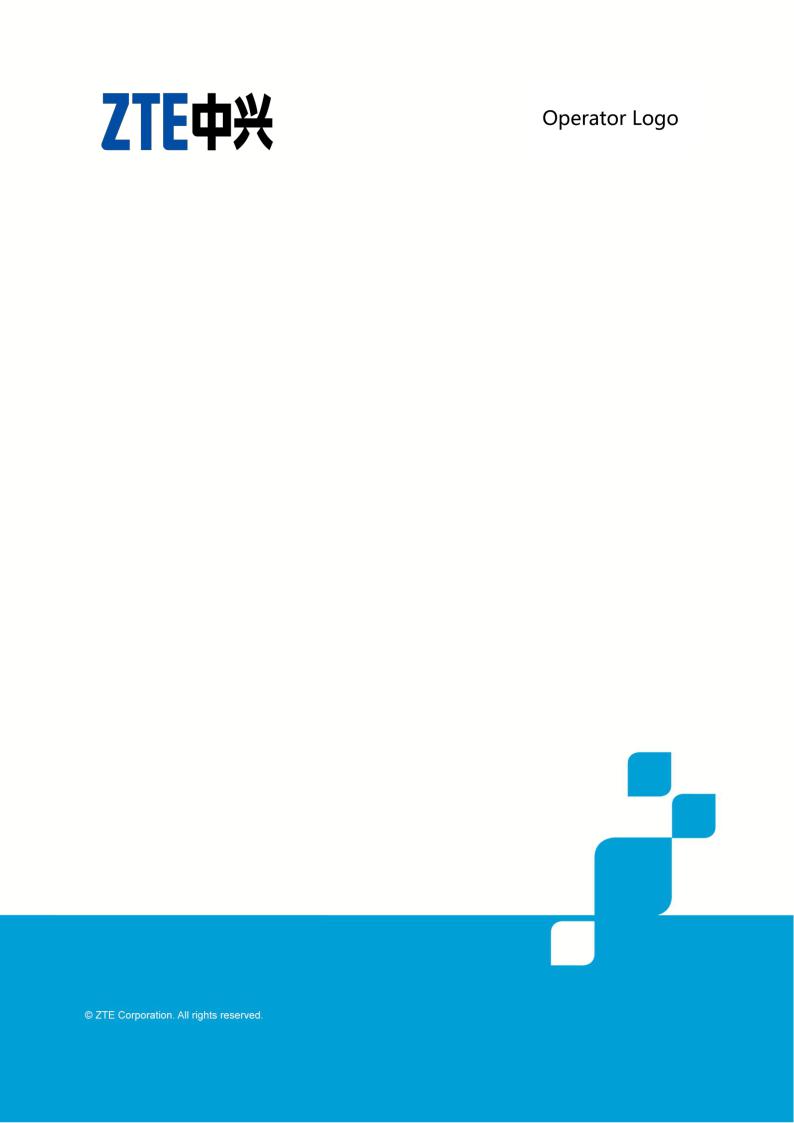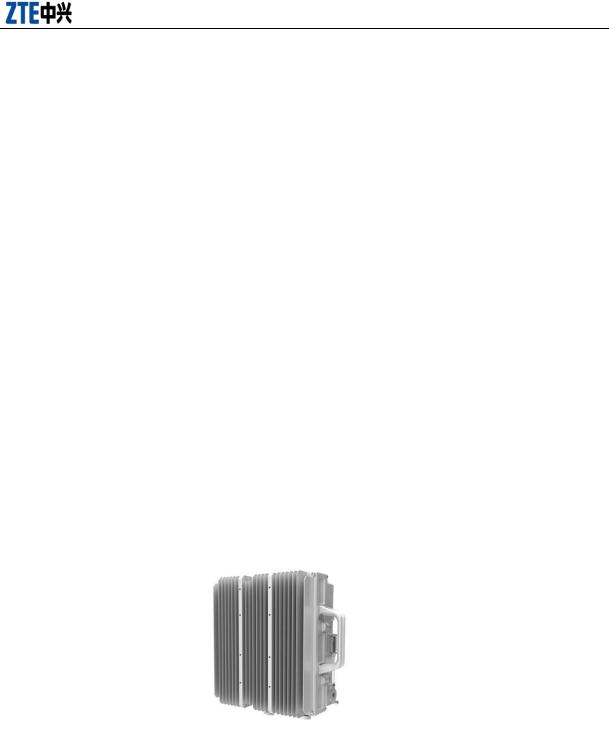ZTE R8881S1900L, R8881S1900H, R8881S8500 User Manual

ZXSDR R8881 Product Description
UR13

ZXSDR R8881 Product Description
ZXSDR R8881 Product Description
Version |
Date |
Author |
Reviewer |
Notes |
|
|
|
|
|
|
|
V1.00 |
2014-05-30 |
Yang Lisha |
Chen Yong, Yang |
First release, information of GSM, UMTS |
|
Xu |
dual-mode are all included |
||||
|
|
|
|||
|
|
|
|
|
|
|
|
|
|
|
|
|
|
|
|
|
© 2015 ZTE Corporation. All rights reserved.
ZTE CONFIDENTIAL: This document contains proprietary information of ZTE and is not to be disclosed or used without the prior written permission of ZTE.
Due to update and improvement of ZTE products and technologies, information in this document is subjected to change without notice.
ZTE Confidential & Proprietary |
1 |

ZXSDR R8881 Product Description
TABLE OF CONTENTS
1 |
Overview ............................................................................................................ |
5 |
1.1 |
Introduction .......................................................................................................... |
5 |
1.2 |
Benefits................................................................................................................ |
5 |
1.3 |
Application Scenarios .......................................................................................... |
6 |
2 |
Product Architecture......................................................................................... |
7 |
2.1 |
Physical Structure ................................................................................................ |
7 |
2.2 |
Hardware Structure.............................................................................................. |
7 |
2.2.1 |
Transceiver (RTR) ............................................................................................... |
8 |
2.2.2 |
Power Amplifier (PA).......................................................................................... |
10 |
2.2.3 |
Duplexer (DFL) .................................................................................................. |
10 |
2.2.4 |
Power Supply (PWR) ......................................................................................... |
11 |
2.2.5 |
Lightning Protection Module (PIB)...................................................................... |
11 |
2.3 |
External Interfaces ............................................................................................. |
11 |
2.4 |
Software Architecture......................................................................................... |
13 |
2.5 |
Functionality....................................................................................................... |
14 |
3 |
Technical Specifications................................................................................. |
15 |
3.1 |
Physical Indices ................................................................................................. |
15 |
3.2 |
Performance Indices .......................................................................................... |
16 |
3.2.1 |
Operation Frequency Band ................................................................................ |
16 |
3.2.2 |
Capacity............................................................................................................. |
16 |
3.2.3 |
Receiver Sensitivity............................................................................................ |
16 |
3.2.4 |
TOC Output Power ............................................................................................ |
17 |
3.3 |
Power Indices .................................................................................................... |
17 |
3.3.1 |
Power Supply..................................................................................................... |
17 |
3.3.2 |
Power Consumption........................................................................................... |
17 |
3.4 |
Transmission ..................................................................................................... |
18 |
3.5 |
Working Environment......................................................................................... |
18 |
3.6 |
Electromagnetic Compatibility ............................................................................ |
18 |
3.7 |
Reliability ........................................................................................................... |
19 |
4 |
Installation ....................................................................................................... |
19 |
5 |
Configurations................................................................................................. |
20 |
6 |
Warning and Note............................................................................................ |
20 |
7 |
Abbreviation .................................................................................................... |
21 |
2 |
|
ZTE Confidential & Proprietary |

ZXSDR R8881 Product Description
ZTE Confidential & Proprietary |
3 |

ZXSDR R8881 Product Description
FIGURES |
|
|
|
Figure 1-1 |
R8881 |
Physical Structure .................................................................................. |
5 |
Figure 2-1 |
R8881 |
System Structure.................................................................................... |
7 |
Figure 2-2 |
R8881 |
External Interfaces ................................................................................ |
12 |
Figure 2-3 |
SDR BTS Software Structure............................................................................ |
13 |
|
TABLES |
|
|
|
|
Table 2-1 |
R8881 |
Modules................................................................................................... |
7 |
|
Table 2-2 R8881 External Interfaces Description ............................................................... |
12 |
|||
Table 3-1 R8881 80W |
Physical Indices.............................................................................. |
15 |
||
Table 3-2 R8881 80W |
Operation Frequency Band ............................................................ |
16 |
||
Table 3-3 R8881 80W |
Capacity ......................................................................................... |
16 |
||
Table 3-4 R8881 Static Receiver Sensitivity ...................................................................... |
16 |
|||
Table 3-5 R8881 TOC Output Power ................................................................................. |
17 |
|||
Table 3-6 R8881 Power Supply ......................................................................................... |
17 |
|||
Table 3-7 |
R8881 |
80W |
Power Consumption in UMTS Single Mode.................................... |
17 |
Table 3-8 |
R8881 |
80W |
Power Consumption in GSM Single Mode...................................... |
17 |
Table 3-9 |
R8881 |
80W |
Power Consumption in G/U Dual-Mode.......................................... |
18 |
Table 3-10 R8881 CPRI Interfaces .................................................................................... |
18 |
|||
Table 3-11 R8881 Environment Condition Compatibility .................................................... |
18 |
|||
Table 3-12 R8881 Reliability Characteristics...................................................................... |
19 |
|||
4 |
ZTE Confidential & Proprietary |

ZXSDR R8881 Product Description
1 Overview
1.1Introduction
With the multi-mode era coming, ZTE, who is dedicated to providing comprehensive network solutions and delivering the future-oriented quality network for the operators, developed the ground breaking SDR unified platform with the essential feature to support multi-mode and multi-band radio access.
Based on this innovative SDR platform, ZTE promotes a series of products to satisfy different scenario requirements, including the indoor macro, outdoor macro, distributed, outdoor micro, mini and pico base station. In this document, R8881 is introduced.
ZTE ZXSDR R8881 (hereinafter referred to as R8881) is a distributed Remote Radio Unit (RRU) used in ZTE Uni-RAN solution, with 1-way transmitting and 2-way receiving. R8881 80W works in GSM or UMTS single mode or multi-mode.
Figure 1-1 R8881 Physical Structure
1.2Benefits
R8881 is one of the most widely used remote radio units in ZTE SDR base station series. The following part lists the key benefits for operators.
High performance
ZTE Confidential & Proprietary |
5 |

ZXSDR R8881 Product Description
To meet with the growing demands for wide working bandwidth, R8881 modules with full working bandwidth are released. Maximum working bandwidth of R8881 is 75MHz for 1800M band and 35MHz for 900M band. For frequency spectrums become scarce, resources allocated for operators tend to be characterized with fragmentation and large span. RRUs with full working bandwidth integrate more spectrum resources and help to decrease hardware investment exponentially. (This is the maximum bandwidth of the RF modules. Please make the actual module as the standard.)
Clearer and simpler network
R8881 supports GSM, UMTS, or mixed technologies. Instead of running hardware on independent platforms for each technology, operators can implement various wireless technologies in software on the same hardware platform.
Since hardware platforms can be reused, there is significantly less investment risk for deploying hardware. Wireless technologies are developing so fast, and investing on one technology may bring risks to operators. SDR-based solutions will decrease the investment risk since SDR platform can support various technologies.
High PA Efficiency, Low Power Consumption
The PA of R8881 achieves high efficiency with ZTE patent Doherty, Digital Pre-Distortion (DPD) and Dynamic Power Trace (D-PT) technologies. The PA power supply voltage is dynamically adapted to the output power, reducing RU’s power consumption.
1.3Application Scenarios
The R8881s and one base band unit (BBU) form a complete BTS/NodeB. It implements radio transmission in the covered area, controls radio channels and communicates with the Base Station Controller (BSC/RNC). It supports indoor and outdoor applications.
6 |
ZTE Confidential & Proprietary |
